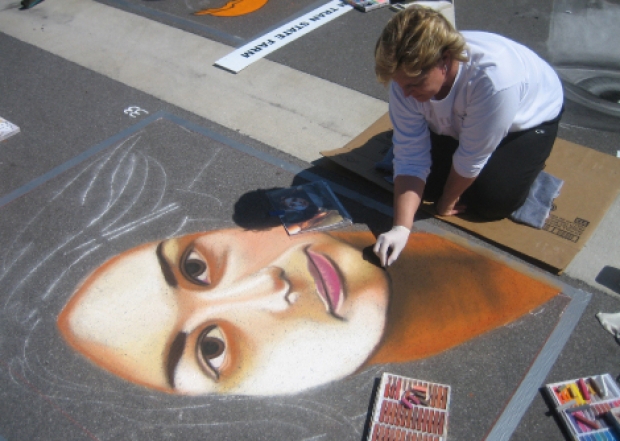Street painter Lee Jones brings the artistic process to life

For most artists, the act of creation requires an isolated work space, hours of thoughtful concentration, and long periods of solitude. It’s usually in such a quiet atmosphere that the mythical muse descends, granting divine inspiration to the devoted artisan. However, for street painter Lee Jones, activity, conversation and frequent interruptions are all part of the formula for creating award-winning art.
Jones has used pastel chalk to create more than 200 street paintings over the past 16 years, with subjects ranging from Italian masters’ reproductions, to portraits, to animals, to nature scenes. The size of her works ranges from 4 feet square to 15 feet square, and she produces them in a time span of six hours to three days. Though the art of street painting originated in 16th century Italy as a means for artists to market their talent and gain commission work, it’s enjoyed a renaissance of sorts over the past few decades. At festivals and events around the world, artists create their work spontaneously, in a public atmosphere, on sidewalks or pastel paper. Jones, who has picked up slews of awards and accolades over the years, will bring her talent to the Pawleys Island Festival of Music and Art for the second year, at the Chalk Walk, on Sunday, October 2.
“It’s as much about the performance as it is about the art,” Jones says of her craft. At any of the 12 to 15 festivals she attends each year, Jones can be found chalking on the sidewalk alongside novice festival attendees. The atmosphere is wide open, outside, and inviting to anyone who feels inclined to grab a pastel and have a go at it. Jones may be working on a Michelangelo reproduction through the course of a day, yet when other chalkers have a problem or a question, she takes a break from her art to talk, offer advice or answer questions.
It’s a far cry from the vision of the solitary artist working in a vacuum, yet Jones says the social nature of street painting is perfect for her. “I’m a very social person,” she explains. “I’m not an introvert, and I don’t do well by myself. People ask me all the time, ‘You’re such a good artist; why aren’t you in a studio working?’ The answer is, I’d go out of my flipping mind! I’m best in social situations because I get to interact with people while I’m doing my artwork.” As for the interruptions to her chalking, Jones says, “I look at it as a nice relief. I get to talk about the art form with someone who’s experiencing it with me. And when I really get into a conversation, I’m getting a break off the sidewalk.”
In addition to the social outlet, Jones enjoys the teaching element that her career offers. When she travels from her home in Orlando to Pawleys Island for the festival, she’ll arrive several days before her scheduled event to work with children in area schools. “I hold workshops in the classroom so I can show them techniques, and then we go outside and work,” Jones explains. “I love working with the kids—it’s my favorite thing.”
Another unique aspect of street painting that suits Jones just fine is the fleeting nature of the final product. Within moments, a rain shower or pressure washer could erase all evidence of her day’s work, yet Jones explains that the temporal nature of the art form is part of its appeal: “In our line of work, the finished product is a photograph. At many festivals, they’re there to erase it, wash the sidewalk, almost immediately after I’m done,” she says. “You can preserve it, but that’s not the nature of the art form; it’s supposed to be temporary.” Street painters, she says, “don’t get as attached to our work as other artists. ... With street painting, you can walk away after the day is done. I’ll be so over it after two days—I think, ‘I’m so glad this is done.’ I sign my name, take a picture, and walk away.”
Jones often chalks with her 14-year-old daughter, Brin, who has also won awards at festivals around the nation. “She’s going to be way better than I will be,” Jones says, “partly because she’s had an earlier start; I didn’t start until 32, and she started at 8.” In addition, Jones’ father is a street painter, though, interestingly, each family member’s work has a distinct look. “My father has a very Monet, impressionistic style,” Jones explains. “Mine is more realistic, and my daughter’s, graphic.”
For Jones, the social and creative outlets of street painting equal an ideal career and lifestyle. Though the art form takes a physical toll—she has had surgery on both knees in the past year as a result of extended periods of kneeling on a sidewalk—the benefits far outweigh the drawbacks. “If I had to have surgery again, I’d do it again,” she says. “That’s how much I love street painting.”